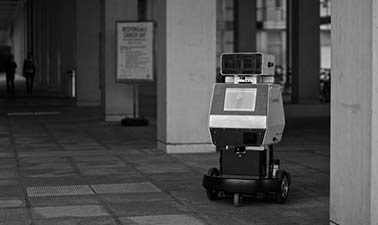Introduction to Autonomous Mobile Robots

About this Course
Robots are rapidly evolving from factory workhorses, which are physically bound to their work-cells, to increasingly complex machines capable of performing challenging tasks in our daily environment. The objective of this course is to provide the basic concepts and algorithms required to develop mobile robots that act autonomously in complex environments. The main emphasis is put on mobile robot locomotion and kinematics, environment perception, probabilistic map based localization and mapping, and motion planning. The lectures and exercises of this course introduce several types of robots such as wheeled robots, legged robots and drones.
This lecture closely follows the textbook Introduction to Autonomous Mobile Robots by Roland Siegwart, Illah Nourbakhsh, Davide Scaramuzza, The MIT Press, second edition 2011. All required readings are available within the courseware, courtesy of The MIT Press. A print version of the course textbook, Introduction to Autonomous Mobile Robots, is also available for purchase. The MIT Press is offering enrolled students a special 30% discount on books ordered directly through the publisher’s website. To take advantage of this offer, please use promotion code IAMR30 at the MIT Press site.
Prerequisites
Good basic mathematics, physics, system modeling, and control.
Grading and Evaluation
Problem sets and quizzes do not count towards your final grade. There will be a written session exam which will solely determine your final grade. Nevertheless, we highly encourage you to do these quizzes and problem sets because they are very useful to test your understanding and prepare you for the exam.
Optional Exercises
In addition to the graded content, this course offers 6 ungraded exercises in which students can write perception and planning software for a mobile robot that runs in simulation. The programming part is in Matlab or Octave and the simulation runs in the V-Rep simulator.
Schedule
| Week | Topic |
|---|---|
| 1 | Introduction and Motivation |
| 2 | Locomotion Concepts |
| Ex1 | Introduction to the V-Rep Simulator |
| 3 | Mobile Robots Kinematics |
| 4 | Perception I |
| 5 | Perception II |
| Ex2 | Kinematics and Control of a Differential Drive Vehicle |
| 6 | Perception III |
| 7 | Perception IV |
| Ex3 | Line Extraction |
| Q1 | Quiz 1 |
| 8 | Localization I |
| 9 | Localization II |
| Ex4 | Line-based Extended Kalman Filter |
| 10 | SLAM I |
| 11 | SLAM II |
| Ex5 | EKF SLAM |
| 12 | Planning I |
| 13 | Planning II |
| Ex6 | Dijkstra's Algorithm and the Dynamic Window |
| Q2 | Quiz 2 |
| 14 | Summary |

